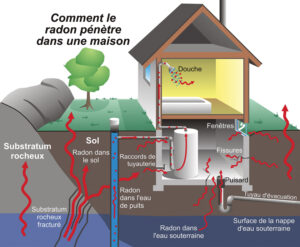Over the past 5 years, working from home has become increasingly popular. Whereas it was once uncommon, this form of working has now been widely adopted by companies. In fact, 10% of workers had a hybrid working arrangement, and over 14% worked exclusively from home in 2023.
For many people, working from home is an opportunity to rethink the layout of their rooms. They take the opportunity to create a comfortable workspace, adapted to the long hours of work ahead. In fact, the basement is often the chosen location for the home office. That said, it’s the place where radon, a radioactive gas, levels can be highest.
Varying from region to region and property to property, radon in homes is more prevalent than you might think. Currently, 1 in 5 homes are believed to have an abnormally high level of this radioactive gas, causing serious health problems for occupants of the property. In Quebec, Health Canada tolerates a level of 200 Bq/m3 (becquerels per cubic meter). However, several properties exceed three times the Canadian guideline.
In this article, you will learn more about the importance of performing a radon test and ways to treat issues that may be found. Trust the experts at Groupe Durasec to implement efficient radon mitigation measures in your home.
What is radon?
The radon in our homes comes from uranium present in the ground and rock which breaks down over time. This creates a radioactive gas that is highly harmful to your health. Radon detection is difficult as it is completely invisible to the naked eye, painless and tasteless.
As we spend long days at home, we are therefore significantly exposed to this gas that has been proven to lead to risks of lung cancer deaths and other health problems.
Radon testing is the sole responsibility of homeowners. Many families are therefore struggling with this toxic gas without even knowing it. In the long term, the higher the exposure, the greater the health risks. In addition, in confined spaces like a house, gas concentration rise more quickly, which increases the risks associated with radon.
In 2021, more than 17% of properties do not meet the Bq/m3 standard imposed by Health Canada. This statistic is likely to increase over the coming years. Indeed, only a small percentage of buildings undergo testing.

How to detect radon in homes?
Radon can infiltrate the air in your home in a number of ways. Cracks in the floor, joints in pipes and windows are among the most notable examples. The same is true of dirt floors, construction joints and crawl spaces. Floor drains and faucets can also allow radon-rich groundwater to enter.
Generally, radon testing should be performed by a qualified professional every 5 years. We note that newer homes seem to present higher risks of radon exposure. This is because new homes are less airtight than existing ones. As a result, they are more susceptible to water infiltration and other problems.
Remember that only a radon test kit can detect any anomalies. To measure its significant presence, it is necessary to use a dosimeter such as the one offered by AccuStar Canada. By installing it inside your property for a minimum of 3 months and following the supplier’s instructions, you will get the exact statistics as well as a report on the concentration of radon in your home.
Based on this report, Groupe Durasec specialists will be able to develop an effective mitigation plan. This will aim to preserve the health of your family by reducing your exposure to this harmful gas.
How do you eliminate radon?
You tested your residence and the results are higher than the Canadian guidelines? The first thing to do is refrain from panicking. Groupe Durasec experts guarantee that, following their passage, the exposure rate will not exceed 100 Bq/m3. Our goal is always to get as close as possible to 0 Bq/m3.
If your home requires work to eradicate radon, be aware that there are deadlines to be met. There are also certain costs involved that can quickly become significant. For radon gas levels over 600 Bq/m3, we recommend to carry out the work within the current year. For radon levels between 200 and 600 Bq/m3 , a timeframe of less than 2 years is preferable.
To mitigate radon in your home, we select high quality materials and install them to give you peace of mind. When the work is complete, we give you a device with which you can verify that the system is fulfilling its primary function properly.
Since prolonged exposure to radon is closely associated with the development of serious illnesses. Exposure to radon increases the risk of lung cancer. Indeed, it is one of the most common and leading causes of lung cancer after smoking. This alone should convince you, as the homeowner, to perform a radon test and measure the radon levels in your home.
High levels of radon in indoor air is not to be taken lightly. Testing should be a priority for every homeowner who wishes to minimize their risk of developing lung cancer. Keeping a close eye on this radioactive particle will help you preserve the health of you and your family.
*National Radon Competence Program in Canada, Radon Certification in Canada NCRP

